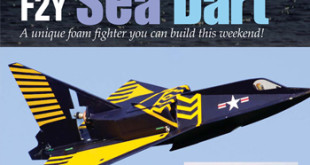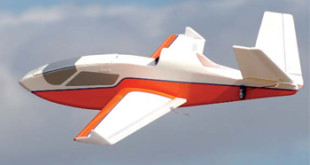Regular Fly RC readers will recall the microflight milestones achieved by Martin Newell of San Jose, CA. We reported in the February 2006 issue that Martin was the first to break the 1-gram barrier for an electric radio-control model. At the 2006 NEAT Fair, Martin was at it again with his .695-gram model—the first under 700 milligrams.
Read More »Monthly Archives: January 2011
Parkzone T-28 Trojan RTF
Success and recognition can be challenging goals, especially when you are trying to escape the shadow of a more famous older sibling. Such is exactly the case for North American’s T-28 Trojan. Following the WWII-era T-6 Texan trainer—of which over 17,000 examples have served the armed forces of almost 50 countries— the T-28 had some pretty big shoes to fill.
Read More »JR X9303 2.4 Radio System
In my March/April 2005 “Radio Spectrum†column in RCM magazine, the topic was a truly revolutionary radio system—the XP9303 from JR (Horizon Hobby). This 9-channel radio system has a 30-model memory and three model types (airplane, sailplane and helicopter) with virtually limitless programming options via a unique rolling selector system. This 72MHz system became my favorite; now it has been improved with a built-in 2.4 Spread Spectrum system (add-on modules for the 72 version are also available).
Read More »Futaba 12FG Radio System
Positioned neatly between Futaba’s sport radio line and itsextreme high-end systems, the new 12FG is a full-tilt, top-end,no-holds-barred radio in a very refined package. Though missingsome of the bling of the 12Z and 14MZ, you don’t have to pay foranything that you might not really need. When you’re flying, mostimportant are all the little things that add up to a higher level of controlover your prized model; there, this radio doesn’t skimp on anything. Ifyou want the best for less, look closely at Futaba’s new 12FG radio.
Read More »Maxford USA Gee Bee Model Y
Built in 1931, the Model Y is widely regarded as the finest flying Gee Bee to come out of the Granville brothers’ Springfield, MA, shop. Though it doesn’t have the familiar Gee Bee silhouette, the Model Y exemplifies the grace and elegance that make Golden Age aircraft so appealing. Originally conceived as a two-place sport flyer, the Model Y’s smooth handling and high performance also made it a natural for racing and aerobatic displays.
Read More »Convair F2Y Sea Dart
The Sea Dart builds very quickly using traditional sheet foam construction techniques. Begin by cutting a set of parts from 3mm Great Planes ProFormance Foam. Next install the 1mm x 3mm carbon reinforcements in the wing and fin leading edges. Now install the 3mm carbon tube main wing reinforcement. Next, cut a 45-degree bevel on the leading edge of the elevons and install them with Du-Bro #916 electric flyer hinge tape. Now we are ready to start final assembly!
Read More »New Moon EDF Jet
Build Your Own Fantasy Jet! CLICK HERE to download the New Moon Plan (Tiled Version)
Read More »Expand The Versatility of a Dremel Tool
Most modelers consider the Dremel tool to be a must-have accessory for the workshop. They use them for any number of routine tasks, from trimming music wire to sanding, drilling, grinding and shaping. Many modelers I have talked to don’t ask their Dremels for much more than that though, and this is a shame.
Read More »Flying The Harrier
As 3D flying becomes more common, I see pilots from every conceivable realm of RC flight expressing a guarded interest in learning how to fly some of the more basic 3D maneuvers. Damping this enthusiasm is a misconception that only the best of the best RC pilots can fly 3D. That isn’t the case at all. With a little understanding and the right airplane, I find that even the most hesitant 3D pilots can be successful and have a lot of fun exploring 3D flight.
Read More » Fly RC Magazine WE LIVE RC
Fly RC Magazine WE LIVE RC


